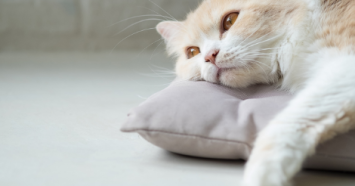
There’s a fun cat picture that has circulated online for years where a cat owner explains “How to pill a cat in 13 easy steps,” and concludes that it might be best to keep a hamster instead.
You’ll never find me backing any plan to keep hamsters over cats, but I don’t disagree that some cats are a nightmare to medicate. This discomforting reality is especially apparent when you consider how easy it is to get a dog to swallow a pill. Wrap it in peanut butter and voilá – you’re done. But cats? Not so much.
Not all cats are difficult to medicate. I’ve found plenty of cats who are surprisingly easy going on this issue. Open their mouths with the tip of a syringe and they’ll down every drop. Place a pill on their tongue and they’ll swallow it quickly. Got a powder, pill, or elixir you want to mix into their food? No complaints.
But these are the outliers. The majority of felines will spit up the pill, drool out the liquid, and turn their nose up at a “contaminated” food bowl. Then there are those who won’t even let you get close enough to try.
Fortunately, there are some tricks vets, vet techs, pet sitters, and other pet professionals have developed and mastered that might help.
How to Give a Cat a Pill
Hold the top of your cat’s head with your non-dominant hand, just as if you were holding a baseball, and crook your fingers and thumb underneath their cheekbones.
Crane their head back so that it’s pointing up. You’ll notice their mouth will open as you do this, and it’s usually just enough of an opening for you to pop a pill in with your dominant hand (I sometimes just drop it in so I don’t risk the wrath of those teeth.).
Close their mouth gently and wait for them to swallow.
You’ll usually know they’re done this when they lick their nose at which time you can release your hold on their head and hope they don’t spit it back out somehow.
How to Give a Cat Liquid Medicine
Hold the top of your cat’s head as for the pilling method, but do not crane their head backwards.
Insert the tip of the syringe into one of the corners of their closed mouth.
Slowly depress the plunger on the syringe, waiting patiently for them to swallow bits of it as you go. If you’re doing it right, you’ll see their throat “gulping” as they take the meds.
Administering a liquid may sound like an easier process, but I happen to believe pills are simpler. Cats differ though, so it’s always worth trying a liquid when pills prove difficult. Sometimes cats respond well to some liquids and pills and poorly to others, so ask your veterinarian how most cats tend to prefer the pill or liquid versions of the meds prescribed.
Medicating a Difficult or Resisting Cat
Many cats do NOT want that nasty stuff in them and they’re sure to tell you with as many of their “tools” as they can.
My approach to these cat patients is to first find out how badly they’re willing to hurt me. If I conclude they’re not terribly serious about making me go away (i.e., they’re not threatening to actually bite), I wrap them in a towel, burrito-style, and try the above tactics.
If they’re especially tough, I’ll enlist additional help to hold as I medicate or vice-versa. A pilling gun or some other such tool may be necessary here. Pilling tools allow you to remain away from feline teeth while allowing you to get deeper down into the oral cavity with the pill itself.
Dealing with Regurgitators or Droolers
Some cats are masterful rejecters of pills and liquid and can actually manage to bring up the item as if it’s nothing but kibble. Or they’ll spit it out in a stringy dribble of drug-tinged drool.
For these, I employ the next two tips.
The Pill Disguise
Try commercially available pill hiding treats for cats to help them take their meds to start, but beware that most cats will take the secreted pills at first only to figure it out and spit them out behind your bed or under your sofa.
Alternative Approaches
Some conditions are treatable through other means. For example, radioactive iodide can cure cats of hyperthyroidism thereby relieving you of medicating for that particular disease. And believe it or not, almost all cats prefer subcutaneous injections to pills and liquids.
Alternatively, some medications can be formulated as a gel that can be absorbed through the skin. This “transdermal” approach is one many compounding pharmacies will prepare for their animal patients whose unwillingness to take medication makes treatment otherwise impossible.
Practice Medicating Cats Early
One thing I’ll say in favor of medicating sick kittens under eight weeks old is that these babies tend to grow up into easier to treat cats. Young kittens who must be medicated frequently during their socialization window (between two and seven weeks of age) will almost inevitably learn to tolerate being medicated and remain easy going about it into adulthood.
This does not mean to medicate unnecessarily – but practice going about the motions so that your cat does not get alarmed when you try to open their mouth or tilt their head back.